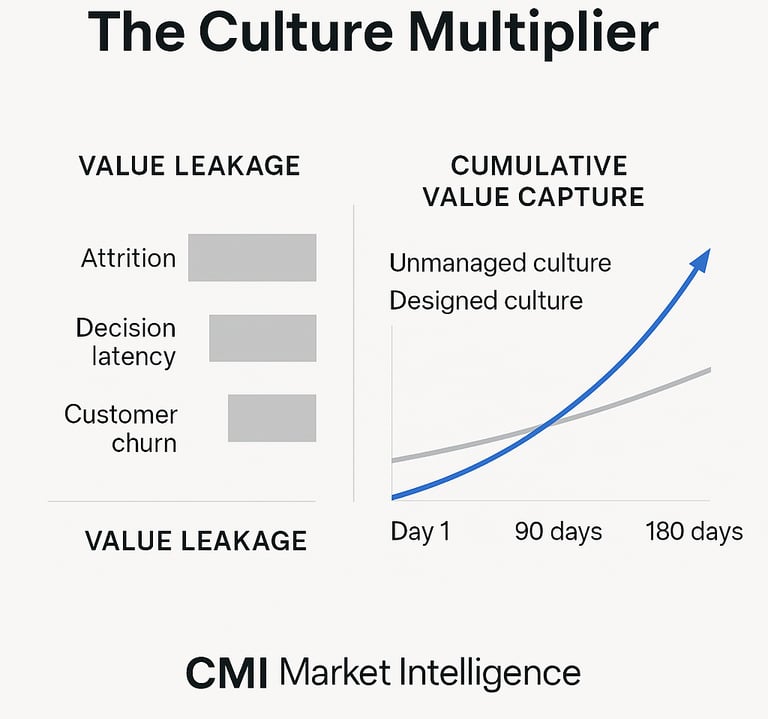
How disciplined cultural integration protects your downside, accelerates synergies, and compounds value.
Most deals are decided on strategy and numbers. Most deals miss their targets because of people. Culture—how decisions get made, how conflict is handled, what gets rewarded, how fast teams move—isn’t a soft factor at the edges of a transaction. It’s the operating system that determines whether the deal thesis survives first contact with reality. When leadership treats culture as a managed workstream instead of a poster on the wall, two things happen: risk is contained where deals usually leak value, and upside compounds faster because adoption of new ways of working actually occurs.
Think of culture as the mechanism that governs cycle time. In diligence, you model revenue synergies from cross-sell, margin lift from procurement, and cost savings from consolidating functions. None of that translates into cash unless people adopt different behaviors—routing accounts differently, making decisions at a new cadence, using a shared platform, participating in a new review rhythm. If the acquiring company defaults to “we’ll blend the best of both,” the typical outcome is decision ambiguity, political vetoes, and quiet attrition where you can least afford it. If, instead, culture is handled with the same discipline as TSA, IT cutovers, and synergy tracking, the organization moves through Day-1 and the first 180 days with momentum intact.
The most practical way to manage culture in M&A is to treat it as a sequence of linked commitments: diagnose what truly drives performance, design the employee experience you intend to deliver, and hard-wire those choices into operating mechanisms you can measure. What follows is a concise field guide for doing that work well, plus two anonymized case notes that show what “good” looks like.
Culture is the operating system of a merged company
Executives often talk about culture as “how we do things around here.” That’s a useful shorthand, but in integrations it needs to be explicit. Culture is the set of observable behaviors and decision rights that determine how work flows: who decides, what information is considered credible, how trade-offs are made, how fast escalation occurs, how people and teams are recognized, and where truth gets spoken when it’s uncomfortable. When you define it that way, it becomes immediately measurable and manageable.
In deal settings, a few cultural mismatches destroy value more reliably than others. Decision latency is the first: one company prizes consensus and risk minimization, the other rewards speed and reversible bets. Put them together without design and you get slow decisions right when you need fast ones—org design, pricing, customer migration, product roadmap. Another is recognition and autonomy: if the acquirer centralizes and the acquired company derived performance from empowered local leaders, regrettable attrition appears in exactly the roles you need for revenue continuity. A third is communication and candor: if bad news has historically been punished, integration risks stay underground until they are expensive.
The cure is not to average the two cultures into something bland. The cure is to identify the few non-negotiable mechanisms that make each side effective, choose which to preserve, and then wire those choices into the way the combined company actually runs.




Diagnose the work, not the vibes Before you promise the future, map how work currently gets done on both sides. Keep it short and behavioral: decision style (centralized vs. distributed), pace (sprints vs. gates), risk posture, conflict handling, customer ownership norms, and the rituals that anchor performance (for example, weekly product reviews, peer feedback forums, field-led pipeline calls). You’re not trying to write a coffee-table book; you’re looking for two or three mismatches that, if left unmanaged, will sink key synergies.
Name the non-negotiables Every organization has a few keystone rituals that enable its edge. Protect them explicitly. If a target’s creative or engineering performance depends on a candid peer-review ritual, preserve it. If the acquirer’s strength is disciplined operating reviews that surface issues early, export that mechanism to the acquired teams. The point isn’t to protect feelings; it’s to protect performance.
How to manage culture with rigor
Translate gaps into execution risk and into the model. If your cross-sell thesis assumes rapid adoption of shared account planning but the acquired sales culture is highly autonomous and relationship-driven, build the enablement, incentives, and governance to make the new motion real—and adjust the timing in your model accordingly. Cultural realism is better than spreadsheet optimism.
Put culture under governance. A disciplined Integration Management Office should host a Culture & Organization workstream with real authority. Its charter: maintain the leadership behavior “contract,” run the communications cadence, track talent moves, tune operating mechanisms, and escalate when non-negotiables are at risk. Treat escalations about culture the same way you treat escalations about customer stability or major IT cutovers.
Measure leading indicators. Long before the P&L shows success or failure, culture shows up in forward signals: regrettable attrition in pivotal roles, decision-cycle time for defined decisions, adoption of new processes, early synergy run-rate, customer churn in overlapping accounts, and employee NPS segmented for integration-critical squads. Review these like you review pipeline and cash.
Align talent and incentives early. Move your best integrators into the awkward seams. Staff value-critical roles with leaders who model the chosen behaviors. Pay for the collaboration and speed you need to realize synergies; do not assume cultural change occurs without reinforcement.
Hard-wire culture into operating mechanisms. If a behavior matters, it should show up in a recurring forum or artifact: quarterly business reviews, product and roadmap reviews, capitalization gates, talent reviews, pricing councils. Replace slogans with cadences. When the calendar and the agenda change, behaviors change.
Design Day-1 as an experience, not a meeting. People infer truth from symbols. Who speaks on Day-1, which leaders are placed in charge of value-critical areas, what gets praised in the first week, and where the first cross-company wins are harvested—those choices tell employees what the future will actually feel like. Day-1 should make three commitments concrete: what will be preserved, what will change, and how decisions will be made while the dust settles.
Make decision rights explicit and simple. Publish a one-page integration “constitution” that clarifies who decides on customers, people, product, capital, and exceptions in the first six months. Ambiguity is the enemy of speed; clarity lowers temperature and accelerates adoption.


© 2025 CurveMind Inc. All rights reserved. CMI Market Intelligence is a division of CurveMind Inc.
